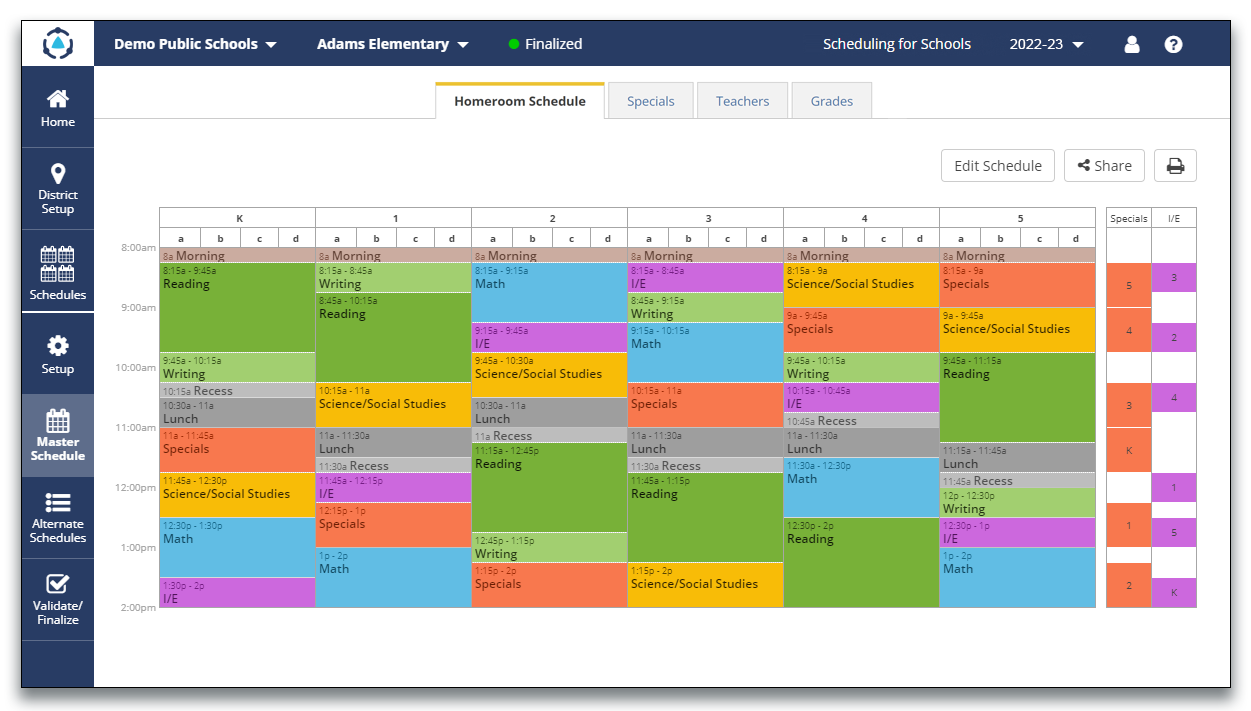
Building an Elementary Schedule - Part 4: Scheduling Specials Classes
This 12-part series on How to Build an Elementary School Schedule offers step-by-step guidance and proven scheduling strategies for creating a better elementary school schedule.
Specials in Elementary School like Art, Music, Physical Education, and Technology Can Help Your Students Thrive
Often, special periods are considered to be the most complicated and frustrating aspects of elementary school scheduling at all grade levels. In large part, specials classes are among the most severely constrained periods of a school day in terms of facility space and staffing. Consequently, many schools rely on historical scheduling practices year after year instead of seeking alternative and potentially more effective approaches.
To offer your students a well-balanced curriculum and help them develop new skills, we recommend that you start building your schedule by placing your specials periods first. Here are some ideas you might find helpful when considering how to schedule specials.
1. Confirm your district and school's specials staffing plan
More and more, specials staff are being shared across one or more buildings per day or across the week. Many districts have been doing this for years while others are starting to adopt this nimble approach. Sharing staff can accommodate changing student needs based on fluctuations in enrollment and highly constrained budgets.
Understand your school's needs
Start by understanding your school's needs (e.g. the type of specials classes such as music, arts, physical education, technology, or world languages, as well as the number of specials sections by day and specials cycle). In partnership with your school district leaders, develop a plan that effectively shares teachers across buildings by pairing schools and designing a staff-sharing plan that limits travel while optimizing specials coverage.
Note, school pairings may shift each year based on changing needs and therefore should not simply become static sharing arrangements year over year. Ensure specials schedule cycles are in sync between schools that share staff with one another.
Whenever possible, try to limit travel between schools during the day by assigning shared staff to a school for an entire day. This can influence specials rotations, but can help ensure students across schools continue to get access to a rich set of specials offerings.
2. Create opportunities for grade-level collaboration time
Schedule specials for all sections of a grade at the same time and for the same duration. Grade-level scheduling allows homeroom teachers to have daily common planning time opportunities, among other benefits.
3. Prioritize morning core instruction for lower grades
Organize specials for older students in the morning and for younger students in the afternoon. This helps younger students to engage in core instruction earlier in the day when energy levels are high!
4. Plan teacher time and transitions
To allow teachers to change materials between grades, consider transition time between specials periods. By reducing the dramatic differences in materials needed for each grade, scheduling specials by grade sequentially can also reduce transition time. Don’t forget to allow time for specials teachers' planning and lunches as well.
5. Consider the most suitable specials rotation for your school
Special rotations are available beyond the traditional Monday through Friday schedule cycles (e.g. three-day, four-day, week-long, semester, quarterly, etc.). Choose the option that best suits your facility and staffing constraints while providing your students with equal access to specials.
6. Ensure that sections are evenly distributed per grade level
Consider regrouping students for specials if one grade has more sections than other grades (e.g. regrouping five sections into four). Sometimes regrouping can help you manage larger grades more cost-effectively while accommodating facility and staff constraints.
7. Design specials at each grade level thoughtfully
Introducing students to specials, whether physical education, music, arts, or technology, is essential for their education.
Establish grade-level specials rotations with only one specialist per specials period. Typically, this is done by aligning the maximum number of sections per grade to the number of specials offered, unless regrouping is used.
Specials can be one of the most difficult periods to schedule, so scheduling them first will enable you to build your elementary school schedule successfully. The above considerations can also assist you in identifying your school's optimal rotation for specials.
Need Support with Scheduling?
DMSchedules Can Help.
The key to scheduling success is preparation and planning. Start taking action now so that you and your scheduling team are well-positioned for success this scheduling season. If you need help building your elementary school schedule, reach out to us. We can take scheduling off your plate, and create your school schedule aligned with your learning goals.

